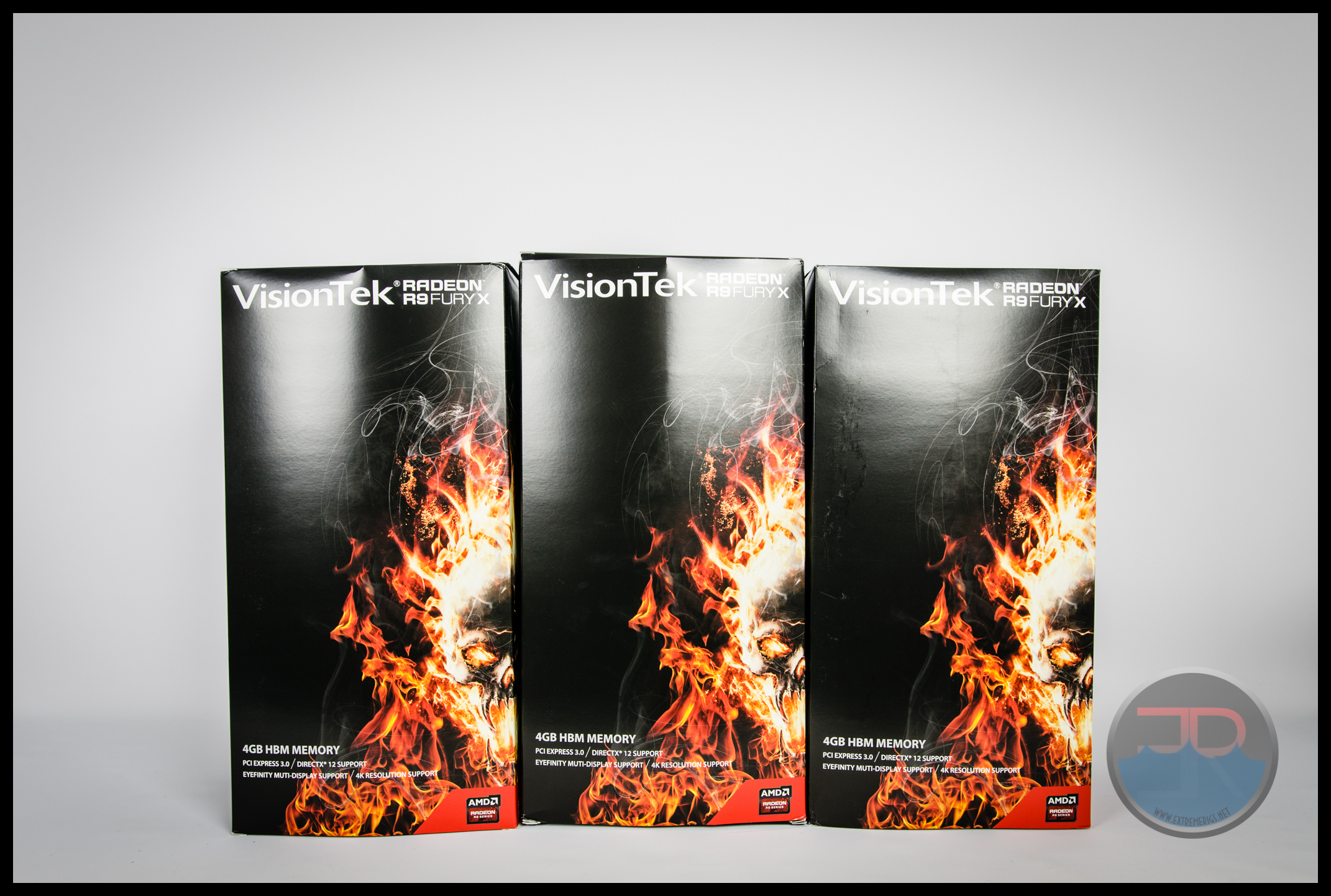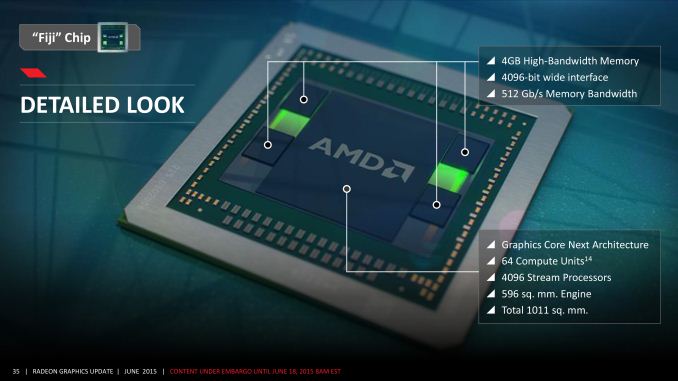Review: Titan X vs Fury X in a Triple CFX SLI Showdown
AMD finally launched the successor to the long in the tooth R9-290X in June. The new silicon is codenamed Fiji – in line with AMD’s pacific island codename theme. However the product is called the “Fury X” – no doubt AMD wanted an answer to Nvidia’s Titan branding that was a marketing success.
The Fury X is an incredibly important GPU for AMD. The previous generation’s R9-290X was a great performing GPU when it launched back in October of 2013. It was competitively priced and alongside its value orientated little brother the R9-290 caused Nvidia to drop their prices on the GTX780 and release a surprisingly fully enabled GTX780 TI one month later. While the R9-290X was a great performing card it’s sales were hurt by two things. Firstly the performance reviews were hurt by its high power and terrible cooling. The reference card would often self throttle below stock clocks because it would get too hot and the air cooler was loud. On top of that the card was great at compute – a feature that Nvidia had partly stripped out of the mainstream Kepler units; when the Alt Coin mining craze hit in late 2013 the graphics cards were in huge demand and prices spiked as demand soared. This seemed like a good thing for AMD at the time, but when the mining market evaporated in April of 2014 there was suddenly a glut of high mileage cards from ex-miners flooding the market. Resale prices dropped causing retail demand to plummet. 290s could be had for significantly less than lower performing Nvidia cards causing an unfair belief that the cards were actually not as good as they were.
So after nearly two years AMD have finally given us something new. So what does the Fury bring to the table?
Technology
The most obvious benefit that could have occurred was a die shrink. Smaller transistors sizes usually equate to lower power, higher speed and more cores/die. However both Nvidia and AMD are stuck on the 28nm process node as TSMC have had huge difficulties with their smaller processes. As a result the last few years of GPU improvements have been all about architectural improvements in the GPU design alongside increases in memory size. Fiji however isn’t mainly about the GPU core architecture. Afterall it’s still based on the same “Global Core Next” architecture that powered the R9-290X and 7970 albeit with some minor tweaks to improve efficiency.
HBM
HBM is the key acronym for what’s really new here – it stands for High Bandwidth Memory. In order to decrease the time taken to access memory AMD have taken the external memory chips and integrated them into the same package as the main GPU core:
So what benefit does this bring?
By combining the chips in the same package AMD can use many more connections for the memory bus. Note in AMD’s slide that it states a 4096 bit wide interface. Compare this to the R9-290X with it’s 512 bit wide memory bus and Titan X’s 384 bit wide bus. Having an 8x wider bus means the memory bus speed can be turned down enabling a simpler memory interface controller on the GPU itself. This in turn means more space for graphics processing!
However nothing is without a tradeoff. With the current design and available memory for HBM AMD is limited to equipping the Fury X with only 4GB of VRAM. This is the same as the last generation 290X when it launched and less than the later 8GB editions. For quite a few generations AMD has always offered more VRAM than Nvidia and for some that was a selling point. Now AMD have to try and convince their loyal customers that 4GB is now enough.
Nvidia’s Titan X
Now of course we can’t just dwell on the most recent news coming from AMD. Nvidia launched the 900 series this September, as usual starting with their “flagship” GTX 980 and the slightly cut down GTX 970. While the 980 and 970 were based on the “medium sized” GM204 chip, everybody knew that the bigger brother Maxwell part would arrive shortly afterwards and bring more cores, memory and bandwidth to the table. As with the Kepler generation Nvidia chose to launch the Titan X as a premium product ostensibly geared towards compute. However Maxwell’s limited compute meant that this was really a gaming GPU with more memory and a hefty price tag. Of course since then Nvidia also launched the 980 TI, a card that performed almost as well as the Titan X due to higher boosting clocks.
So let’s take a look at what the two contenders bring to the table today:
As can be seen the two designs are very different even though both are designed in 28nm processes. Nvidia presents us with the ultimate optimization of the traditional GPU design, while AMD are trying something new.
Now that you’re caught up on the technical design of the GPU, lets take a look at these specific models!
















To be honest, I started reading this article with a thought that “well, how good can it be? ERs are watercooling guys so, nah! can’t expect too much”. But after reading the whole of it, I have to say, This is by far the one of the best comparative reviews I’ve ever seen, and really met all my expectations. Hats off to you guys!
Say, FuryX did have the claim in its pre-release rumor to be a TITAN X competitor, but then AMD shrunk that note to 980 Ti. So I think comparison with 980 Ti would’ve been better comparison (and seat clenching brawl) than this, and the clock-to-clock performance metrics but nonetheless, this is wayy too good also!
About capping the vRAM on FuryX in few games there, it also suffers from similar performance degradation on 4K and downwards. And as you may have seen on other reviews, FuryX does worse in sub-4K than the competition and even worse in 1080p. I’ve dug through every review out there yet haven’t found the reason behind this. What could be the reason?
And that scaling on nVidia – you know nvidia does claim that their SLI bridge isn’t a bottleneck, and so it is proved here :P. When AMD did introduce XDMA, I had this belief – AMD took the right path, bridges will suffer from less bandwith sooner or later, and PCIe already has the room for accommodating the data of the bridges. So XDMA did (well, now it is “do” :D) makes sense!
But it’s sad to see AMD not delivering smoother experience overall. If they could handle that thing, this should certainly deserved the choice over any of those higher average FPS of Titan X. But I think AMD is working on Win10 & DX12 optimized drivers and trying to mend it with bandages for now.
My only complain was the choice of TitanX over 980 Ti and clock-to-clock performance, but other than this, this is a very great review! Hats off to you again!
Agreed with Frozen Fractal. I was more than pleasantly surprised with the quality of this review, and I hope you continue to do these more in the future. A 980 Ti would have been nice to see too given the price.
Keep up the great work!
Thanks! I agree the 980 TI would have been a better comparison – then prices would have lined up. “Sadly” we only had Titan X’s and we weren’t willing to go out and buy another 3 GPUs to make that happen. However if anyone wants to send us some we’d gladly run em haha. I was simultaneously impressed with AMD’s results while saddened that after all the work on frame pacing that things still aren’t 100% yet. Hopefully
Question…you overclocked the Titan X to 1495MHz which is “ok” for a water cooling build. I won’t complain…though I’m surprised at why that’s all you were able to achieve as I can pull that off on Air right now (blocks won’t arrive until next week). Main question though…why wasn’t the memory overclocked? A watercooled Titan X has room to OC the memory by 20%, bumping up the bandwidth to 400Gbps, which brings it quite a bit closer to the 512Gbps of the HBM1 in the Fury X.
Although we didn’t mention it the memory was running a mild OC at 7.4Gbps up from the stock 7gbps
6gbps – so yes about the same as your 20% 🙂This is what concerns me about your understanding of overclocking. The Titan X memory is 7GHz at stock. At 7.4GHz you’re only running a 5.7% OC on the memory…
Hah you’re right, I was looking at titan stock memory settings not titan x. Yes it could have been pushed harder. Still though single Titan X was really good compared to Fury X – the issue it had was scaling. So unless scaling is significantly effected by memory bandwidth then I don’t think it changes the overall results much. When we re-run with overclocked furies we’ll spend a bit more time on the Titan X overclock too.
Don’t get me wrong…SLI scaling is definitely an issue and will still exist regardless. But you’d be surprised how important memory clocks can be depending on the test you’re running. I found this out when I was running the original GTX Titan Tri-Sli in the overclock.net unigine valley bench competition and came in second place. Leave the official redo for your next review of Fury X OC vs Titan X OC, as you mentioned. But to satisfy your own curiousity, try a higher memory clock and see what happens. If you were looking to squeeze out every last ounce out of your Titan X, you should check out http://overclocking.guide/nvidia-gtx-titan-x-volt-mod-pencil-vmod/ as well.
My Phobya nanogrease should be coming in tomorrow so I’ll finally be putting my blocks on as well. I’m going to compare my performance results with yours next time you run your benches. So make sure you do a good job. 😉
Excellent review. I am also running an Asus Rampage Extreme V with a 5960x OC’d to 4.4Ghz so your data really was telling. I’m running a single EVGA GTX980TI SC under water. I previously ran 2 Sapphire Tri-X OC R9 290s under water but opted to go with the single card.
Did you use a modded TitanX bios? What OCing tool did you use to OC the TitanX. I would like to try to replicate the parameters and run the single 980TI to see how close I am to your single TitanX data. Thank you.
Eh, i don’t really see the point of running AA in 5K 😛 Too bad it’s 5K btw, 4K is more reasonable. Too bad Fury X has problems with the Nvidia titles(W3 for example).
But man, the scaling and texture compression on amd cards are absolutely amazing. If only they weren’t bottlenecked by the HBM1’s 4GB of VRAM.
[…] Review: Titan X vs Fury X in a Triple CFX SLI Showdown […]
[…] Review: Titan X vs Fury X in a Triple CFX SLI Showdown […]
[…] Review: Titan X vs Fury X in a Triple CFX SLI Showdown […]
Comments are closed.